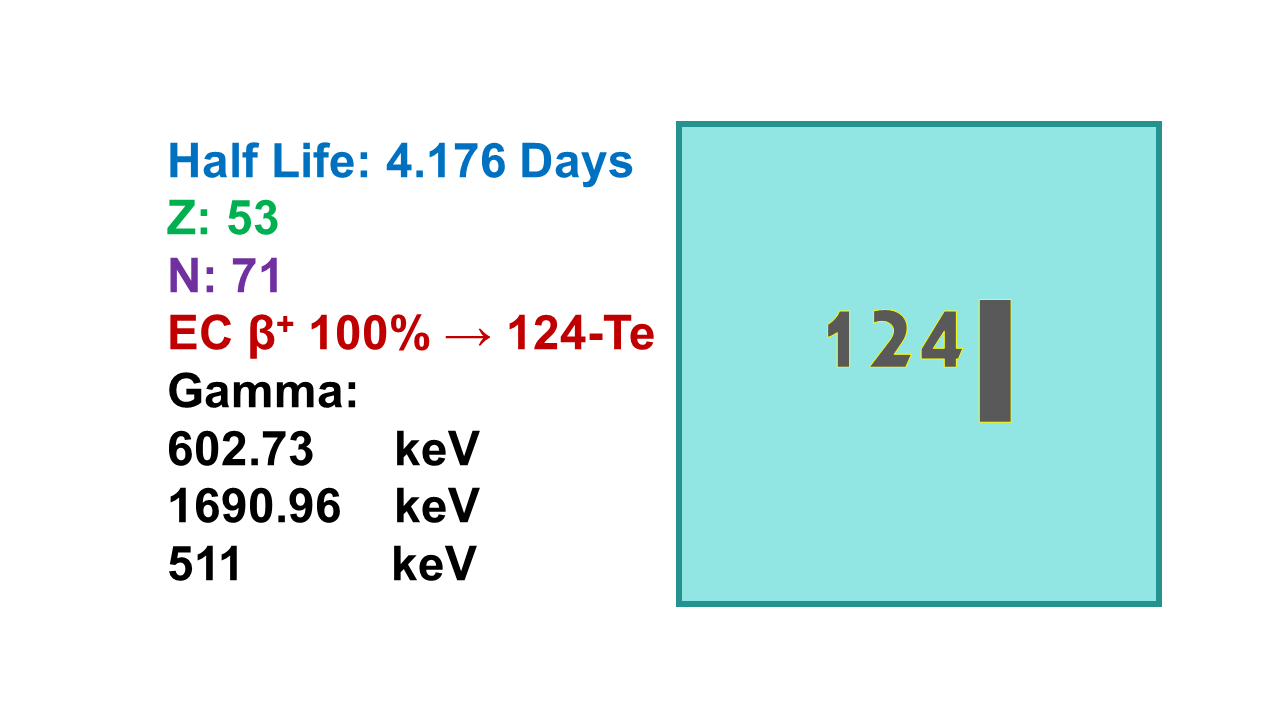
Iodine-124 (124I)
January 17, 2024
Properties:
Iodine-124 (124I) is a long half-life PET imaging radionuclide that can be covalently bound to any organic vector. It decays into stable 124Te with a half-life of 4.18 days with main energies at 2,557 keV (25.1%, ec), 3,160 (24.1%, ec), 1,535 (11.7%, β+), 866 (11.4%, ec) and 2,146 (10.8%, β+) and 603 keV (63%, β+). Average beta plus emission is at 974 keV. The positron emission is followed by annihilation producing two gamma rays at 511 keV. 124I also emits gammas at 603, 723 and 1,691 keV. The half value layer (HVL) is 8.0 mm and the tenth value layer (TVL) is 31 mm for lead.
Manufacturing:
Standard mid-sized cyclotrons can easily be used to prepare 124I. The energy and the type of reaction will define the yields. Three routes are possible: [124Te(p,n)124I] at 8–12 MeV, [125Te(p,2n)124I] at 15 MeV and [124Te(d,2n)124I] at around 16 MeV. Both tellurium isotopes are expensive and can be recycled, but 124Te remains the most affordable. Yields are in the range of 0.5 mCi/µA.h, which means batches of about 0.5–1.0 Ci can easily be obtained.
Source and availability:
124I became recently available as a pharmaceutical-grade PET radionuclide in the frame of the development of an imaging agent for clear cell kidney cancer (Redectane®). Four sites are today able to produce GMP-grade 124I: Cyclotron BV in the Netherlands, IBA Molecular, 3D-Imaging81 and NCM-US in the USA. The long half-life of the radionuclide (4.18 days) considerably reduced the investments in manufacturing units and these three sites are able to cover the present and future short-term needs. If a 124I-labeled tracer comes on the market, the capacity of the existing centers will have to be reconsidered. Some smaller investments will be required, but this should not be a limitation as a high number of existing cyclotrons are able to be upgraded.
Derivatives:
Several other 124I-labeled molecules have been under development thanks to the easy access to this radionuclide. One must however, mention that the high energy of 124I must be considered as a limitation (higher dosimetry for diagnostic) and for long biological half- life process imaging a radionuclide such as 89Zr would definitely have a better profile. Next to 124I-Redectane, one has to mention a few other molecules that are or were under clinical development including 124I-3F8, 124I-TLX101-CDx, 124I-β-CIT, 124I-FIAU, and 124I- Sodium Iodide.
Price:
As a consequence of the availability and easy manufacturing process, the price of 124I will remain low, probably below EUR 500 (US$ 550) per patient dose. Today’s prices do not reflect the real market value.
Issues:
- 124I shows a very high dosimetry to the patient. It seems that the maximum patient dose will be limited to 5 mCi by authorities in the USA and even 2 mCi in Europe. These figures have been extrapolated from data considering the full dose staying in the body until full decay. In reality, if the vector is really specific and brings the tracer only to the target cells and at the same time the clearance allows a fast elimination of the non-specific labeled tracer, probably more than 90% of the radioactivity could be eliminated from the body in less than 24 h. Scientists will have good arguments to contradict healthcare authorities’ constraints, but the discussion may be difficult.
- Free 124I is, like all other iodine isotopes, trapped by the thyroid. The thyroid needs to be protected by prior ingestion of cold iodine to saturate the thyroid cells receptors thus avoiding this expected side-effect.
Comments:
When used for imaging, 124I seems to have a few inherent disadvantages. The relatively high energy of its emitted positron compared to 18F and 89Zr should have a negative influence on the image resolution. In reality, modern PET camera software and algorithms are able to correct the signal and compensate for the higher energy positrons, resulting in images with quality that only marginally differs from that obtained with other isotopes.
However, these high-energy decay rays of 124I also translate into a high dosimetry to the patient. Application of radioactive iodine also needs blockade of the patient thyroid before treatment which is not the case for 89Zr. Use of 124I could therefore, be limited, at least in Europe, despite the favorable chemistry and limited impact on quality of images. Whenever possible, and to avoid difficult future exchanges with authorities, 124I should be replaced by 89Zr.
89Zr will remain more difficult if not impossible to use in neurology as usually metals linked to vectors via a chelating agent do not cross the BBB, still giving a remaining advantage to iodinated derivatives.